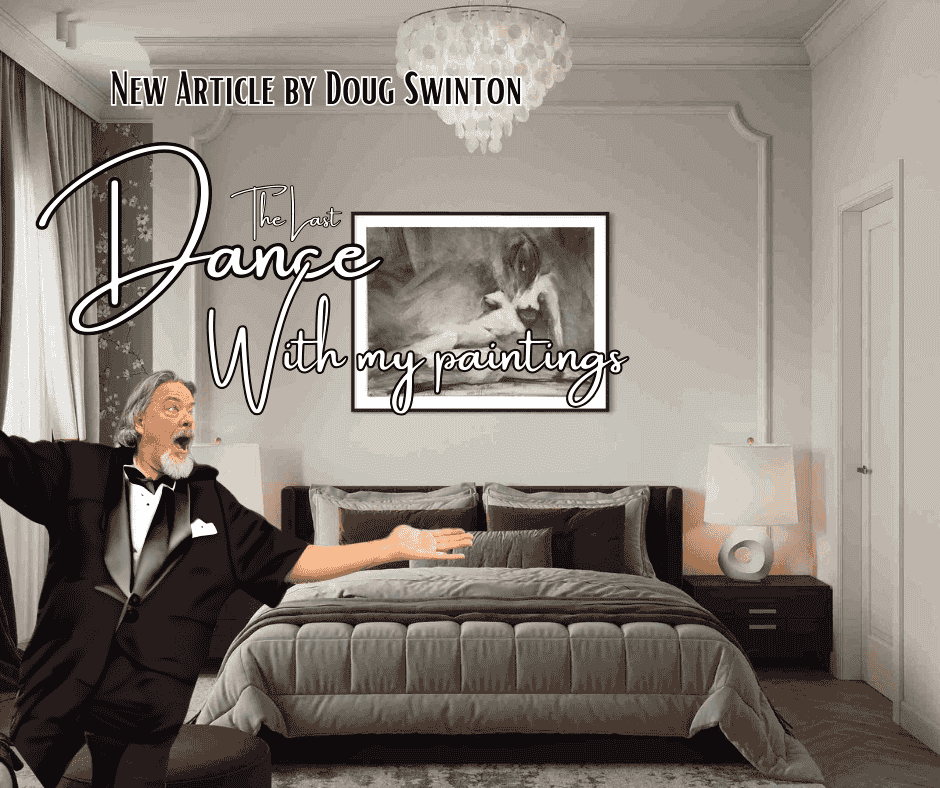Repetition is the key to painting mastery.
- Doug Swinton

- Aug 9, 2017
- 2 min read
Updated: Nov 18, 2020

Discipline needed for artistic self-realization.
In painting, repetition is the key to getting better results. Like warming up with finger exercises on the piano or practicing scales on the guitar, repetition in painting is the key to getting finer work. Even professional athletes continue to hone their skills between games. In the painting game, repetition is one of the disciplines needed for self-realization…
The problem with some artists is their predisposition to want to paint a multitude of random subjects. They paint a portrait on Sunday, neighbours flowers on Monday, a lovely landscape on Tuesday, still life on Wednesday, and on Thursday a street scene emerges from the canvas. Who knows what Friday will bring. I suppose it is the nature of the beast to want to be creative and follow one’s Muse. The problem with this approach is that the artist never gets good at any one style or genre of painting. Every subject requires specific elements and techniques in order to render them correctly.
Repetition makes for a much stronger painter. A painter able to render any subject of choice. Whether you’re painting fur or the nude, it takes practice. To get good at painting clouds, 25 to 40 cloud themes need to be painted before one can get down to their true delicate nature. To understand how the paint lies in the value shifts and the subtle colour temperature changes, the painter needs to produce more than one or two.
Consider the number of cloud paintings Tom Thompson created and multitude of little desert sky studies Maynard Dixon completed. Carl Rungius’s stacks and stacks of mountain studies illustrates his progression towards his later more mature work, allowing for finer compositions and ethereal colour transitions. Paint 25 waterfall paintings and I guarantee you will start to get comfortable with how the water flows at the bottom (which is the part that kills most waterfall scenes). Paint 25 flower paintings and watch how the colours start to come alive and your technique naturally becomes more expressive.
Start by getting some cheapie 8x10 canvas boards (or Arches Oil Paper) and go to town! Cut up a bunch of watercolour paper into small sizes and start to churn the studies out! The ever-stellar painter Julie Hamilton says, “paint and pitch”. Remember, when practicing painting a subject, the process is often more important and interesting than the finished work. You will learn a lot and as a result your imagination will flourish. As the great painter Edgar Payne said. “Memory feeds imagination”.
Your friend in art,
Doug
P.S. Aldro Hibbard spent a lifetime painting snow just to see if he could get it right.








Drive Mad unblocked isn’t just fun—it’s a heart-racing driving test: get your tiny car to the finish, and while picking up the game is simple, the unexpected hurdles in each level make mastering these crazy tracks a true adventure!
AV在线看 AV在线看;
自拍流出 自拍流出;
国产视频 国产视频;
日本无码 日本无码;
动漫肉番 动漫肉番;
吃瓜专区 吃瓜专区;
SM调教 SM调教;
ASMR ASMR;
国产探花 国产探花;
强奸乱伦 强奸乱伦;
AV在线看 AV在线看;
自拍流出 自拍流出;
国产视频 国产视频;
日本无码 日本无码;
动漫肉番 动漫肉番;
吃瓜专区 吃瓜专区;
SM调教 SM调教;
ASMR ASMR;
国产探花 国产探花;
强奸乱伦 强奸乱伦;
代发外链 提权重点击找我;
谷歌蜘蛛池 谷歌蜘蛛池;
Fortune Tiger…
Fortune Tiger…
谷歌权重提升/ 谷歌权重提升;
谷歌seo 谷歌seo;
谷歌霸屏 谷歌霸屏
蜘蛛池 蜘蛛池
谷歌快排 谷歌快排
Google外链 Google外链
谷歌留痕 谷歌留痕
Gái Gọi…
Gái Gọi…
Dịch Vụ…
谷歌霸屏 谷歌霸屏
负面删除 负面删除
币圈推广 币圈推广
Google权重提升 Google权重提升
Google外链 Google外链
google留痕 google留痕
代发外链 提权重点击找我;
谷歌蜘蛛池 谷歌蜘蛛池;
Fortune Tiger…
Fortune Tiger…
谷歌权重提升/ 谷歌权重提升;
谷歌seo 谷歌seo;
谷歌霸屏 谷歌霸屏
蜘蛛池 蜘蛛池
谷歌快排 谷歌快排
Google外链 Google外链
谷歌留痕 谷歌留痕
Gái Gọi…
Gái Gọi…
Dịch Vụ…
谷歌霸屏 谷歌霸屏
负面删除 负面删除
币圈推广 币圈推广
Google权重提升 Google权重提升
Google外链 Google外链
google留痕 google留痕